Antisemitic caricatures had already drawn broad attention from one attentive contemporary observer and passionate collector – Eduard Fuchs, who had published in 1921 a huge volume on Jews in cartoons.1 Already in 1901, he had published what remains to this day the most extensive history of caricatures of the European people.2 The term ‘caricature’ goes back to the cartoons, the “ritrattini carichi”, literally “loaded portraits”, of Annibale Carracci in 16th century Italy.3 But not before the mid-18th century were caricatures used as a medium for political messages. The new art of portrait-caricatures may be understand as the art of making politics visible.4 In current historical research into the cultural aspects of political antisemitism, this iconographic source has received much attention. For nineteenth century Germany Thomas Gräfe, Michaela Haibl or Julia Schäfer for example have studied the manifold features of anti-Semitic cartoons.5 Antisemitic caricatures or political cartoons have even been examined from a German-French comparative perspective.6 Furthermore, this topic, cartoons as historical sources, offers insight into the relationship between the new cultural history of antisemitism and the pictorial turn in historiography.7
Interestingly enough, no attention has so far been given to the image of Antisemites in the cartoons of the Nineteenth century. The purpose of this brief collection of caricatures of antisemites from 1879 to 1914 is therefore twofold. Because of the blank space of German and Austrian antisemitism in this issue, the first intention of this presentation is to exhibit at least some of the most important German and Austrian antisemites. Second, picking up one of Reinhard Rürup’s remark in his commentary, this small collection intends to provide a brief presentation of the “opposing forces” which had taken “a stand against antisemitism”. The images offer a look at the adversaries that arose to antisemitism within German and Austrian civil society.
These cartoons are primarily found in left wing or socialist newspapers, such as the German Der Wahre Jacob or the Austrian Glühlichter. Humoristisch-satirisches Arbeiterblatt. The documents presented here demonstrate that the socialist working class movement – together with the liberal activities and the Jewish response - constituted an effective resistance to antisemitism.8
Furthermore, as these cartoons make clear, from the very outset of the new antisemitic movement, its opponents had a precise understanding of its dominant features. Already at the beginning of the new antijewish agitation initiated by the conservative Prussian newspaper Kreuzzeitung in the summer 1875, the liberal satirical journal Berliner Wespen had published a sharp cartoon ‘Die alte Leier. Das Lied von den schlimmen Juden’ ( The same old tune. The song of the evil Jews) with apposite observations regarding the new quality of this anti-Jewish campaign.9
They also make clear, that contemporaries of the emerging antisemitic movement of the late Nineteenth century still retained a strong historical memory of the Hep-Hep-Riots of 1819, the first outbreak of anti-Jewish violence in nineteenth century Germany.10 In many of these early cartoons, the Hep-Hep-Riots are taken as significant symbols for the new violence against Jews.
Interestingly enough, contemporary observers also correctly perceived the ambivalence in Bismarck’s attitude towards antisemitism, which has been well described by the historian of the emergence of Antisemitism in Imperial Germany, Paul W. Massing, noting that Bismarck must “be considered the first great manipulator of anti-Semitism in modern Germany”.11
Regarding cartoonists themselves, we may determine the author at least for some of the caricatures from the Austrian journal Glühlichter. The caricatures n. 4, 8, 9, 11-14 and 19 are drawn by Friedrich Kaskeline, born in 1863 in Prague, who studied at the Academy of Arts in Vienna. Kaskaline had worked not only for the Glühlichter but also for the magazines like The Graphic or The Daily Graphic. Furthermore he produced illustrations for books and postcards, among others a greeting card for a Jewish New Year.12 The cartoon “Ein antisemitischer ‘Parteitag’” [Fig. 16] is drawn by the artist Fritz Graetz (1875-1915), who had worked after his studies in Frankfurt on the main for example also for the German satirical journals Lustige Blätter and Der wahre Jacob.13 Together with Friedrich Kaskaline he belonged to those artist, who had a determining influence on the profil of the satirical journal. 14 The Schönerer cartoon of 1912 [Fig. 22] on the other hand was drawn by Moriz Jung (1885-1915). After his studies at the arts college in Vienna, Jung had drawn postcards, posters for example and he designed programme booklets for theatres.15
Like other political cartoons, the images presented here, offer not only a humorous side, they also carried unmistakable political-propagandistic meanings in their decisively negative portrayals of the Antisemites. To be sure, even in some of the socialist newspapers, Cartoons may occasionally be found that are not entirely free of antisemitic aspects. Under the “Variations of a well known utterance” in the Glühlichter of 1892 for example, where Lueger is asking if he looks like a ‘Judenfresser’, we see at the bottom of the page a Jewish figure standing in front of the stock exchange, drawn with the typical physiognomy of antisemitic cartoons, asking if he looks like a swindler. Furthermore, at the turn of the century, when Karl Lueger stood at the height of his political power and busily cooperating with the Jewish establishment of Vienna16 - the antisemitic journal Kickeriki pointedly reminded Lueger not to forget his antisemitic catechism. In those years, too, we see in the newspaper Glühlichter occasionally antisemitic or ambivalent cartoons directed (for example) against Lueger’s cooperation with Jewish bankers.
Finally, after the First World War, in the German socialist journal Der wahre Jacob, we can find certain cartoons in which antisemitic features appear, in marked contrast to the overwhelmingly unambiguous anti-antisemitic cartoons of the Nineteenth century.17
However, even the last cartoon presented here from the German Kladderadatsch, which gives a clear picture of the internal conflicts of the antisemitic movement and which treats with irony their passionate quarrels is not free from ambivalent features, as we may see looking at the contentment of the Jew who stands in the foreground.
Nevertheless these cartoons provide us a strong awareness not only of the distinctive and decisive role played by the emergence of the new politics of antisemitism in Imperial Germany and Habsburg Austria, they also offer indisputable evidence that the Jews themselves were by no means alone in their opposition to the new threat.
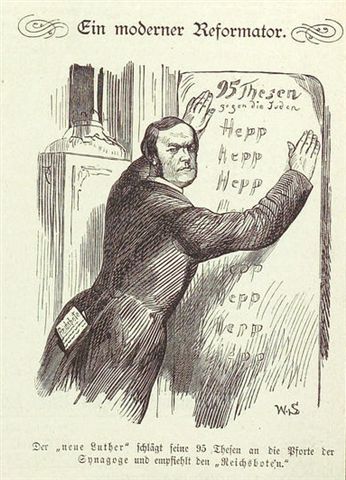
Fig. 1 : “A Modern Reformer”
The Berlin Court preacher Adolph Stoecker (1835-1909) was one of the earliest activists of the antisemitic political movement. Although a theologian, he campaigned against the Jews primarily on social issues. Immediately after his first antisemitic speech and the foundation of his Christian Social Party, the weekly Kladderadatsch presented Stoecker in the pose of Martin Luther posting his 95 theses on the door of a Synagogue. Stoecker’s theses however are composed of the only word ‘Hepp-Hepp’, the battle cry of the early antisemitic riots of 1819 in Germania.
Kladderadatsch. Humoristisch-satirisches Wochenblatt N. 53/54, November, 23rd 1879
Universitätsbibliothek Heidelberg
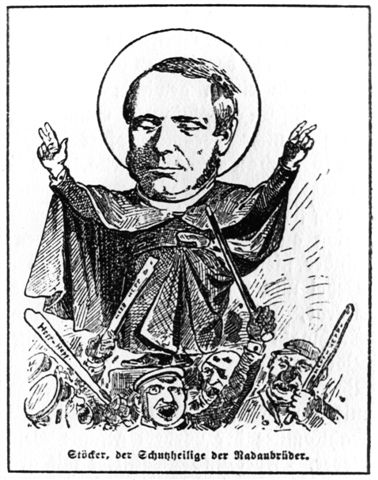
Fig. 2
A cartoon from the social-democratic journal Der Wahre Jacob from 1880 contrasted Stoecker’s position as a court preacher with the conduct of his audience, presenting Stoecker as the „Patron Saint of the hooligans“. His speeches stimulate students and ordinary people to acts of violence against Jews.
Der Wahre Jacob, 1880
Gidal-Bildarchiv, Salomon-Ludwig-Steinheim-Institut
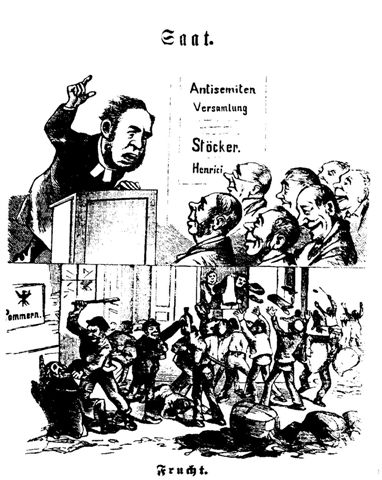
Fig. 3 “Seed and fruit”
After the outbreak of antisemitic violence and the incendiary attack on the synagogue in the small town of Neustettin in Pommerania in 1881, a cartoon in a North German newspaper presented Stoecker’s speeches as the seed, which results in violence against Jews.
Die Reform. Ein Volksblatt, Altona, August, 16th 1881
Carl-von-Ossietzky Universitätsbibliothek Hamburg
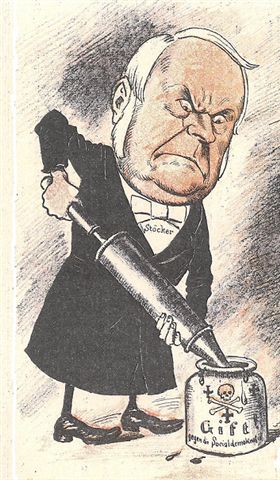
Fig. 4: “For the German Parliamentary Elections”
During the election campaign for the election of the German Parliament in 1893, in which the antisemitic parties enjoyed their greatest success, the Austrian socialist satirical journal Glühlichter published a vicious image of Stoecker, presenting him as one of the most important feeders of the Socialists, “Sozialistenfresser”, filling his injection with poison.
Glühlichter. Humoristisch-satirisches Arbeiterblatt, Wien, June 10th, 1893
Österreichische Nationalbibliothek, Wien
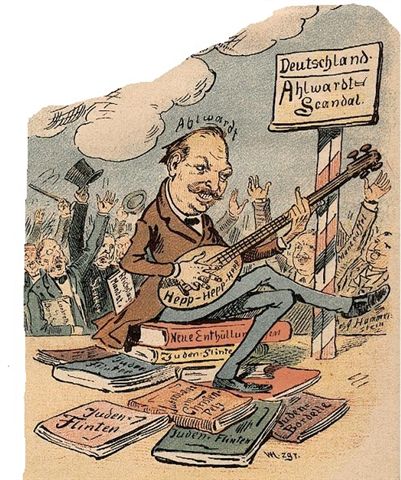
Fig. 5
One of the most spectacular and controversial antisemites in Imperial Germany was the Berlin teacher Hermann Ahlwardt, who had been elected into the German Reichstag in a by-election in 1892. Because of a case of fraud he had been dismissed from teaching, and so he became politically active. After taking a bad hit in the stock market, Ahlwardt caused a sensation with antisemitic brochures and public attacks against Jews, becoming a leading exponent of the so-called ‘Radauantisemiten’, Hooligan-Antisemites. The socialist satirical newspaper ‘Der wahre Jacob’ turned Ahlwardt into a source of ridicule.
Der Wahre Jacob N. 170, 1893
Universitätsbibliothek Heidelberg
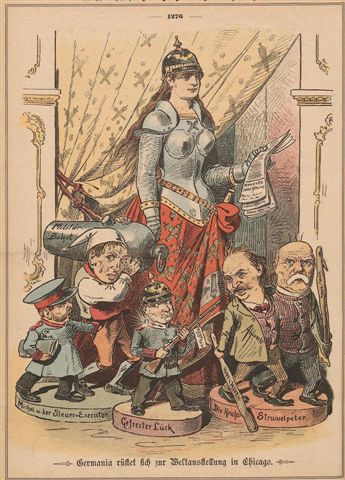
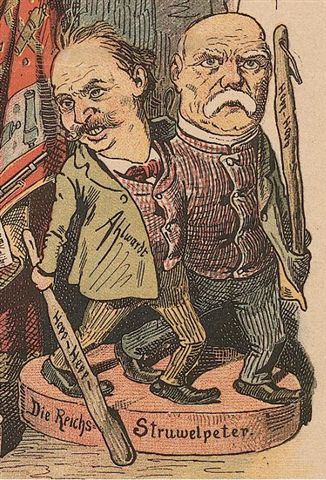
Figg. 6, 6.1 (detail): “Germania is preparing for the world exposition in Chicago”
Even contemporary observers noted the ambivalence in Bismarck’s attitude toward the Jews and the antisemites, and the socialist newspaper Der Wahre Jacob went so far as to depict Bismarck and Ahlwardt as Siamese twins, acting with Hep-Hep cudgels.
Der Wahre Jacob N. 157, 1892
Universitätsbibliothek Heidelberg
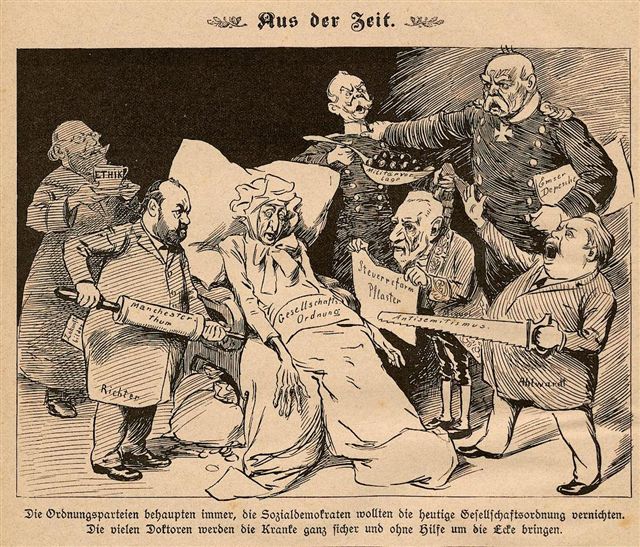
Fig. 7 “From the time”
In a further cartoon from the newspaper Der Wahre Jacob, Bismarck, Ahlwardt and the Antisemites are presented amongst the Figures, representing the conservative Party, the church, the army and the Manchester capitalists as forces that would destroy the social order, whereas the conservative media are accusing the Social democracy of wanting to destroy society.
Der Wahre Jacob N. 169, 1893
Universitätsbibliothek Heidelberg
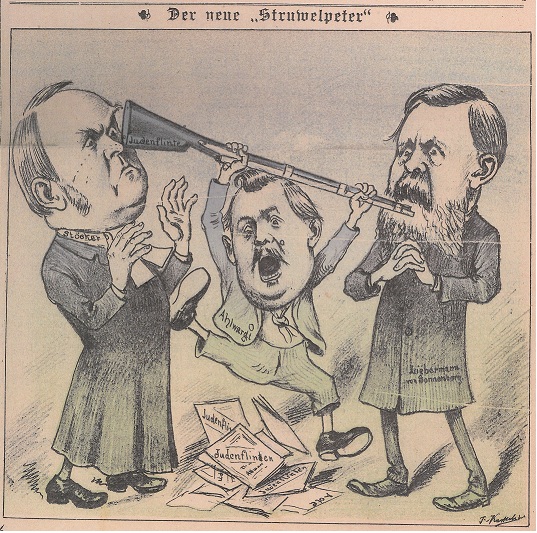
Fig. 8 “The new Shock-headed Peter”
The success of the extreme hooligan Antisemite Ahlwardt in the by-election in 1892 had put the other wings of the antisemitic movement in Germany, the christian-social wing of Stoecker and conservative wing around Max Liebermann von Sonnenberg in a awkward position, attentively remarked upon by the Austrian satirical journal.
Glühlichter. Humoristisch-satirisches Arbeiterblatt, Wien, April, 15th 1893
Österreichische Nationalbibliothek, Wien
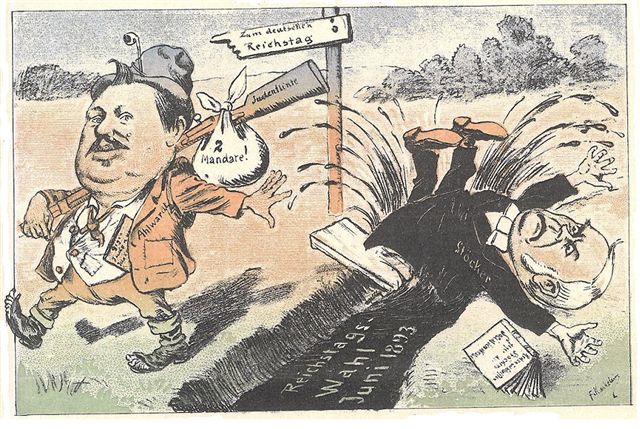
Fig. 9 After the success of Ahlwardt in the general election for the German Reichstag in June 1893 an Austrian cartoon again picked up the internal frictions among German Antisemites, showing how Ahlwardt outclassed even Stoecker.
Glühlichter. Humoristisch-satirisches Arbeiterblatt, Wien, Juni, 22nd 1893
Österreichische Nationalbibliothek, Wien
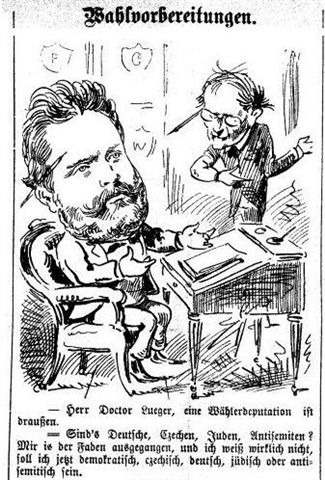
Fig. 10 “In Preparation for the Elections”
In Austria, the former liberal politician Karl Lueger had become the most influential Antisemite within the Habsburg Empire. In the transition period of his conversion to clerical antisemitic positions, the Viennese satirical newspaper Der Floh, The Flea, picked up the opportunistic attitude of Lueger. His attention is called to a delegation for election waiting for him, and he answered: “Are these Germans, Czechs, Jews or Antisemites? I have lost the thread. I really don’t know if I have to be democratic, Czech, German, Jewish or Antisemitic.”
Der Floh. Politisch, humoristische Wochenschrift, May 10th 1885
Österreichische Nationalbibliothek, Wien
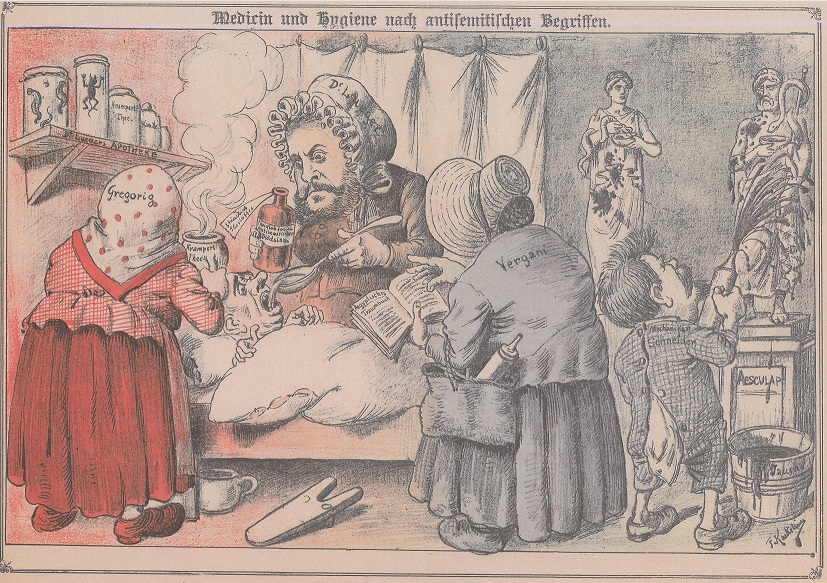
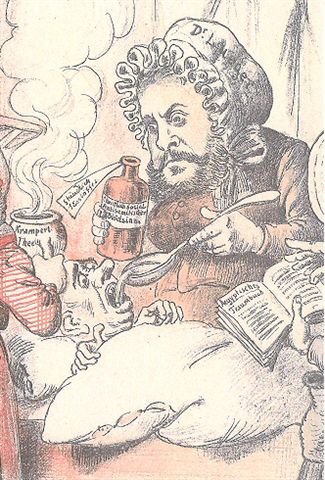
Fig. 11 - 11.1 (detail)
“Medicine and hygiene in antisemitic terms”
After Lueger’s turn to anti-Semitism and preparing the foundation of a Christian-social Party the socialist journal Glühlichter scoffed at the medicine of Lueger, who administered the patient a tincture called “Christian-social antisemitic rubbish”.
Glühlichter. Humoristisch-satirisches Arbeiterblatt, Wien, October 15th 1892
Österreichische Nationalbibliothek, Wien
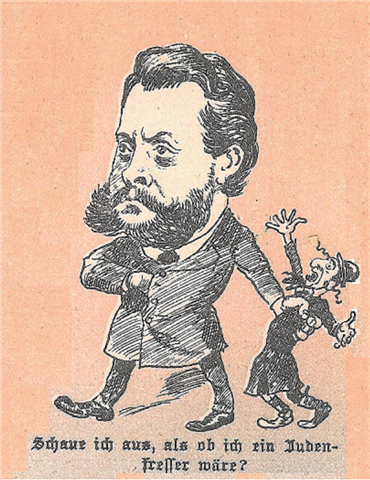
Fig. 12 “Do I look like a rabid antisemite?”
Occasionally, Lueger publicly professed that he was not an antisemite. Under the title “Variations of a well known utterance” the satirical newspaper Glühlichter treated with irony Lueger’s statements.
Glühlichter. Humoristisch-satirisches Arbeiterblatt, December 20th, 1892.
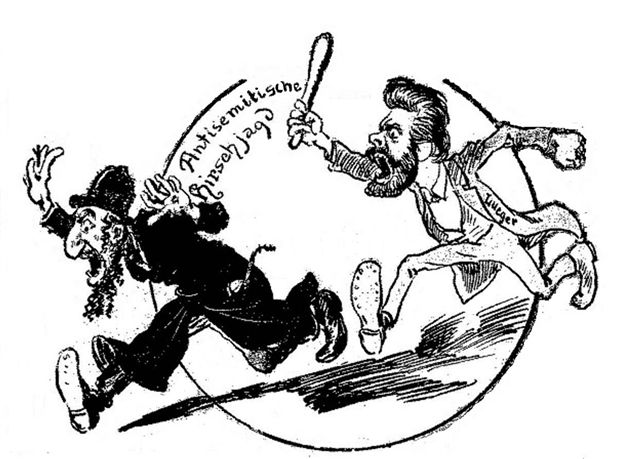
Fig. 13 “Hunting Season”
After the foundation of the Christian-social Party, the Glühlichter, again, critizied the antisemitic policy of Lueger. On the occasion of the beginning of the hunting season 1893 the satirical journal put together various hunting scenes, among them the ‘antisemitic deer hunt’ of Carl Lueger.
Glühlichter. Humoristisch-satirisches Arbeiterblatt, Wien, September, 30th 1893
Österreichische Nationalbibliothek, Wien
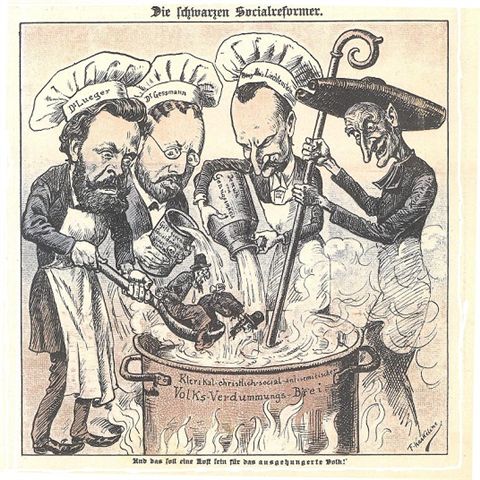
Fig. 14 “The Black-Social Reformer”
After the formulation of the Christian-social program of social reforms, the Viennese satirical socialist newspaper had taken the mickey out of these ‘Black-Social reformers’, presenting them by preparing their “clerical, christian-social, anti-Semitic Peoples-stultification-pulp”. They mixed a tincture of humility and modesty with poison against Social-democracy and boiled this mixture down with the bodies of some Jews.
Glühlichter. Humoristisch-satirisches Arbeiterblatt, Wien, August. 31st 1894
Österreichische Nationalbibliothek, Wien
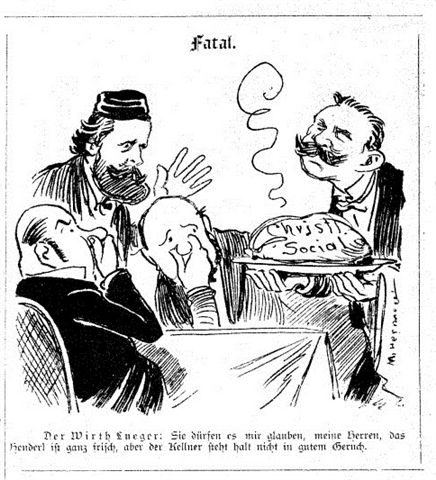
Fig. 15 “Awkward”
After his election victories by the Christian-social Party and the Emperor’s further refusal to appoint Lueger as mayor of Vienna, the satirical newspaper Der Floh treated Lueger’s reputation with irony:
“The proprietor Lueger: You may believe me, Sir, the chicken is really fresh; it is just the waiter that does not smell good.”
Der Floh. Politisch, humoristische Wochenschrift, April 4th, 1897.
Österreichische Nationalbibliothek, Wien
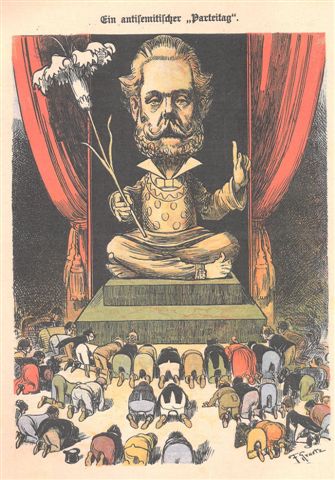
Fig. 16 “An Antisemitic ‘Party Conference’”
In the period of his great political success within the Christian-Social Party, just before his nomination as mayor of Vienna, the socialist newspaper scoffed at the democratic image, Lueger had tried to give from his policy.
Glühlichter. Humoristisch-satirisches Arbeiterblatt, Wien, September 17th 1896
Österreichische Nationalbibliothek, Wien
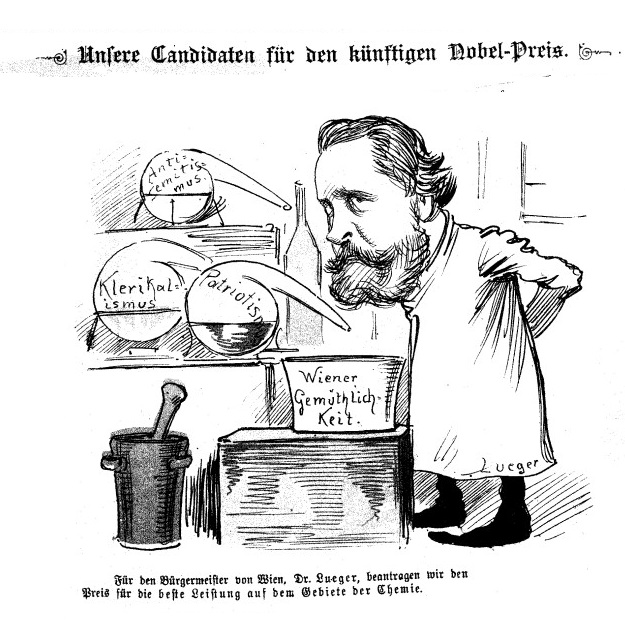
Fig. 17 “Our candidates for the forthcoming Nobel-Prize”
After having been appointed mayor of Vienna and after his public success, the satirical journal Der Floh made fun of Lueger’s political strategy. In the caricature, Lueger, as chemist, mixed different substances, including antisemitism, clericalism, and patriotism, to distil a new liquid called Viennese hospitality.
“We put in an application for a prize for the mayor of Vienna, Karl Lueger: the prize for the best performance in chemistry.“
Der Floh. Politisch, humoristische Wochenschrift, December 29th, 1901
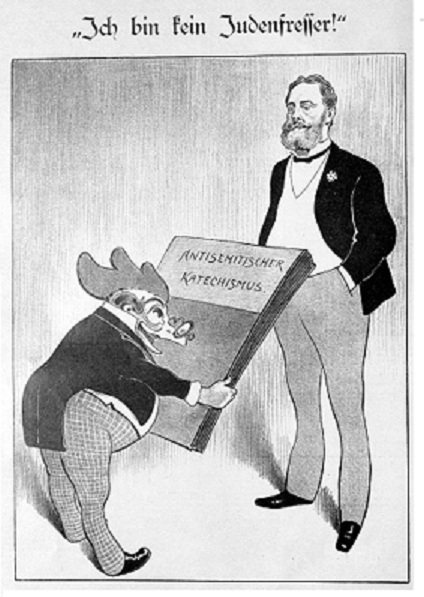
Fig. 18 “I’m no rabid antisemite”
Because of Lueger’s sporadic explanation not to be an antisemite, the open antisemitic satirical newspaper Kikeriki remembered Lueger not to forget his antisemitic convictions and presented him the antisemitic catechism.
Kikeriki, April, 13th, 1905
Österreichische Nationalbibliothek, Wien
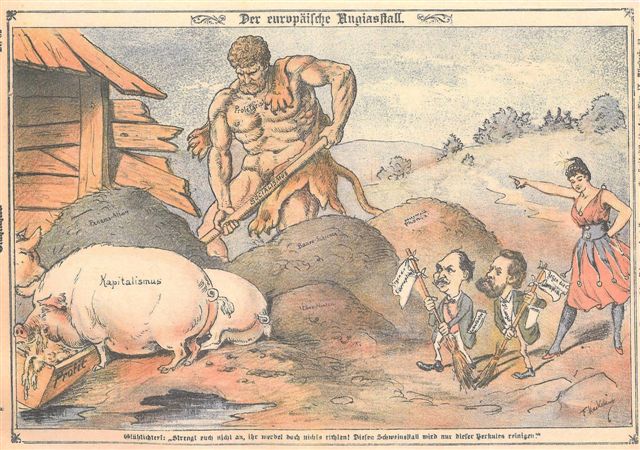
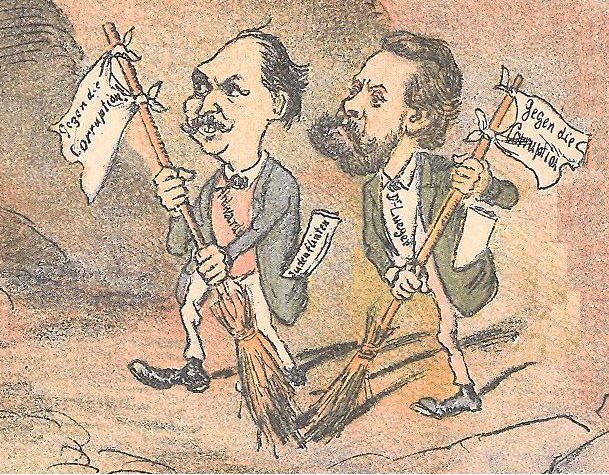
Fig. 19 - 19.1 (detail)“The European Augean stables”
The Austrian journal Glühlichter even picked up the transnational aspects in the alleged fight of German and Austrian Antisemites against Capitalism, getting Lueger together with the anti-capitalistic German Antisemit Hermann Ahlwardt. The personification of the Glühlichter however cautioned them, that they surly won’t be able to clean up this stable of capitalism. Only the Herculean task of the proletariat with the shovel of socialism will succeed.
Glühlichter. Humoristisch-satirisches Arbeiterblatt, Wien, January 3rd, 1893
Österreichische Nationalbibliothek, Wien
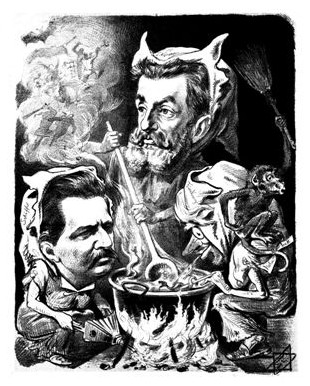
Fig. 20
Next to Lueger, the pan-German politician Georg Ritter von Schönerer was the most prominent Antisemite in Austria. The journal Der Floh presented him together with two other antisemites as witches, boiling an antisemitic brew. In the added poem they shouted: “All the Jews must bleed”.
Der Floh. Politisch, humoristische Wochenschrift N. 17, April, 23rd 1882
Österreichische Nationalbibliothek, Wien
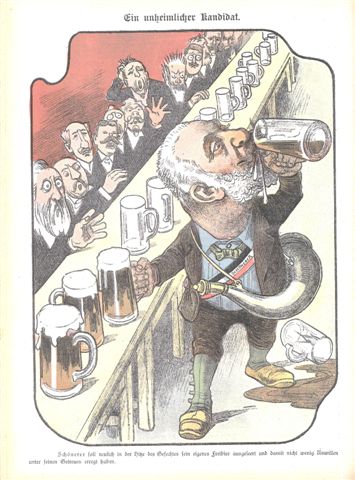
Fig. 21 “An uncanny candidate”
Often, cartoons scoffed at the lifestyle and drinking habits of the antisemitic pan-German Politian and Bismarck-admirer Schönerer. During an election campaign it was said that Schönerer had drunk all of the available free beer, provoking quite a lot displeasure among his followers.
Glühlichter. Humoristisch-satirisches Arbeiterblatt, Wien, May, 8th 1907
Österreichische Nationalbibliothek, Bildarchiv, Wien
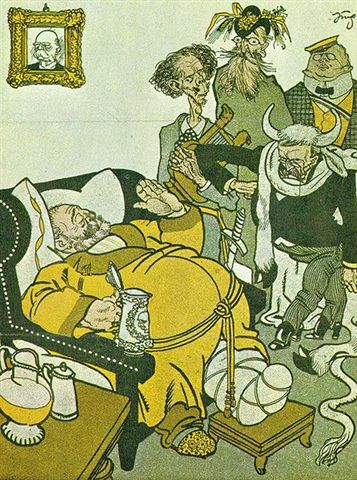
Fig. 22
When the Social-democratic Party gained a huge success in the general elections in Germany in January 1912, the antisemitic pan-German Politician Schönerer is explaining to his comrades to chuck in the pan-German idea: “It is all in vain”, he said. “The German people have become red and international”. Schönerer added that he would rather prefer to turn to an African tribe than to the Socialists. The cartoon picks up again on his drinking habits.
Neue Glühlichter, n. 4, February 1912. Österreichische Nationalbibliothek Wien.
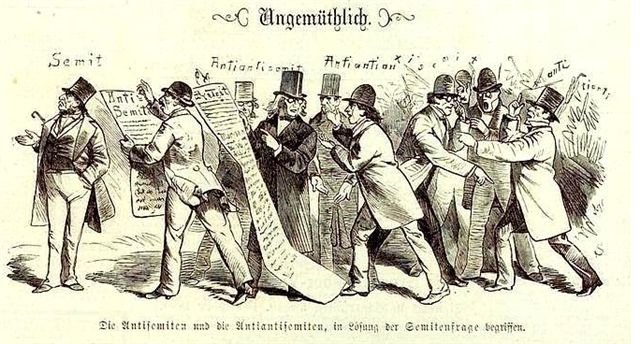
Fig. 23 “Uncomfortable”
At the peak of the Berlin debate on antisemitism, the satirical magazine Kladderadatsch took an ironical view of the quarrels among antisemites and those between antisemites and anti-antisemites.
Kladderadatsch N. 55, November, 28th 1880
Universitätsbibliothek Heidelberg
I would like to thank Richard E. Frankel and Steven Englund for their comments and linguistic corrections